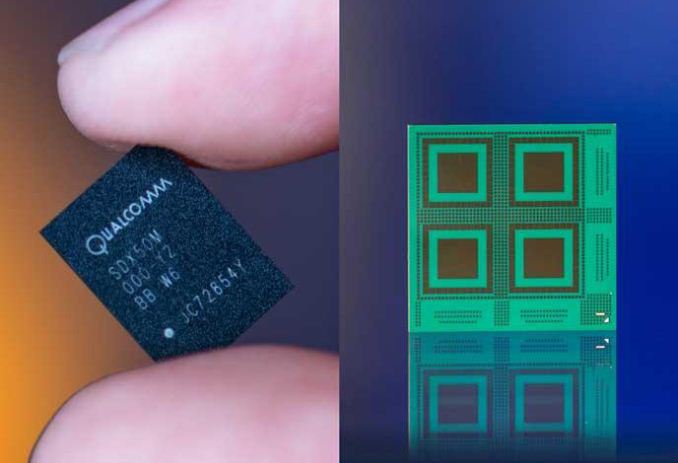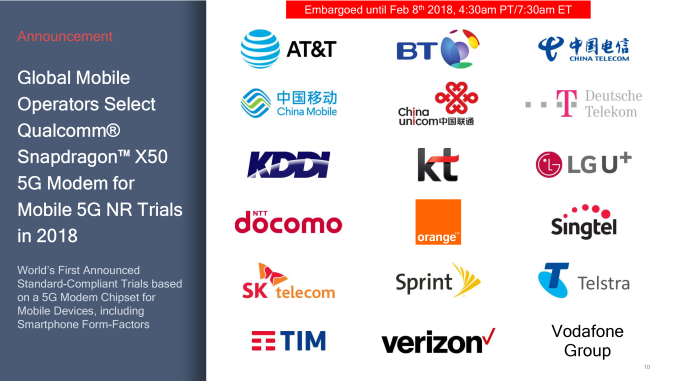Qualcomm Affirms Dozens of Carrier & Manufacturer Partnerships For 5G Trials & 2019 Product Launches
by Ryan Smith on February 8, 2018 7:30 AM EST
With carrier trials for 5G New Radio (NR) cellular communications set to take place later this year, the marketing, promotion, and technical disclosures around 5G technology are picking up at a rapid pace. Similar to what we saw with the launch of LTE networks and devices just short of a decade ago, carriers, device manufacturers, and chipset providers are all anticipating 5G to be a significant market growth opportunity, and as such are all racing to implement the technology into their networks and handsets. At the same time, of course, there is also a significant amount of jockeying for position among all of the parties to be the first to deliver a complete 5G ecosystem, and consequently the bragging rights and potential profits that come from being first.
Arguably at the head of the pack on the user equipment (handset) side is Qualcomm, the 800lb gorilla of the mobile world. The backbone of the company’s business is built around developing cellular technologies and standards, so the company is significantly invested into 5G and is looking to maintain their leadership status for the next generation. To date the company has already announced their first discrete 5G modem, the Snapdragon X50, and with trials less than a year away, they’re already starting to count up the number of carrier and OEM partnerships around the still in development modem.
All told, Qualcomm believes they’re 1-2 years ahead of the competition in the 5G modem space. And while we’re still far enough out that this remains to be seen – Intel wants to ship their own modem in 2019 as well – for the moment Qualcomm does have the edge in as much as they’ve already shown demos of X50 prototypes in action. This also means that at least for the moment, they’re the only game in town for high-performance 5G modems.
To that end, hitting the wire today are a pair of announcements from Qualcomm, who is affirming the dozens of partnerships the company has inked both with carriers and handset manufacturers regarding the use of the X50 modem. Some 18 carriers will be including Qualcomm’s X50-based 5G smartphone reference design in their live trials later this year, and the list is basically a who’s who of carriers. This includes AT&T, Verizon, China Telecom, Orange, and SK Telecom. Notably, all 18 carriers will be testing both the sub-6GHz and all-important millimeter wave frequency bands as part of their trials.
Meanwhile on the handset side of matters, 19 OEMs have now signed on to build and release handsets based around the X50 modem in 2019. As you might expect given Qualcomm’s projected lead, this list of 19 OEMs amounts to just about everyone in the industry, from HTC to OPPO to Xiaomi. In fact it’s probably easier to talk about who isn’t on the list, which are the Big 3: Apple, Samsung, and Huawei. Which as all three design their own SoCs – and in Apple’s case, is also currently involved in litigation with Qualcomm – this is essentially all the vendors Qualcomm could hope to sign in advance and get to agree to such an announcement.
Overall these announcements are definitely a bit of chest-beating on Qualcomm's part, as we’re talking about handsets and networks that won’t be available for over a year. But at the same time it marks the start of the broader 5G adoption process: with the first standard complete (release 15), 5G is no longer an abstract concept, but instead is a near-complete technology that is now less than one complete product development cycle away from being a commercial product. So it is in Qualcomm’s own best interests to continue to woo both technology companies and consumers. Especially as while Qualcomm’s big vision for 5G involves a lot more than just smartphones, it will be consumer demand for the technology that spurs on the creation of the first 5G networks.
Though for that matter it will be interesting to see just what the inclusion of the X50 modem means for handset designs in 2019. Qualcomm has previously revealed that the X50 modem is 5G-only – so it doesn’t include LTE/3G/2G connectivity – meaning that handset manufacturers will still need to incorporate an additional LTE modem (either discrete or as part of the phone’s primary SoC), increasing the total chip count of a handset. Coupled with the array of antennas needed to efficiently work with millimeter wave frequencies, and it definiately puts some pressure on the limited internal volume of phones. With so many manufacturers signed on to use the X50, it may mean that we'll get to see high-end 2019 phones finally break the status-quo in phone design of the last few years in order to accommodate the 5G technology.












22 Comments
View All Comments
Pork@III - Thursday, February 8, 2018 - link
5G will be good but 6G will be final extinction.ch3mn3y - Friday, February 9, 2018 - link
I'm waiting for 10G! It will be... WOW! I'm missing words how mega it will be! :PSydneyBlue120d - Thursday, February 8, 2018 - link
Do You think rumors of a Snapdragon 850 with integrated 5G/4G/3G/2G modem can be real?Pork@III - Thursday, February 8, 2018 - link
If 850 exist :D if no exist then 855Dragonstongue - Thursday, February 8, 2018 - link
"Coupled with the array of antennas needed to efficiently work with millimeter wave frequencies, and it definiately puts some pressure on the limited internal volume of phones"(by the way definitely is spelled wrong ^.^
There is not limited space, rather the makers of these things continuously prioritize making thinner and thinner which tends to increase the fragility factor (coupled with more and more glass) removing things like headphone input (not inside the or as a dual function of charging port) etc.
Many years ago there was a consortium to address the many different types of chargers and to standardize on plug type deal (all except apple who does what they want just because) they really need to standardize an "acceptable dimensions" list as well..such as X thickness or more among other things.
agoyal - Thursday, February 8, 2018 - link
As long as the modem is power efficient and has the right LTE bands, I don’t care about the speed. Most of the time speed beyond 40-50 Mbs don’t mean much to me as I am not downloading big files on phone. I can see why Apple doesn’t care about bleeding edge modemsSamitBasu - Thursday, February 8, 2018 - link
To guarantee you that 50 mbits/s download speed, the basestation must be able to sustain 10 gbits/s or faster because that cell connection is shared with all the users in the cell. So if there are 200 people using 5G, then each get 50 mbits/strivik12 - Thursday, February 8, 2018 - link
I dont see qualcomm having a great future while fighting with Apple. With Qualcomm out of next gen iphones only thing pending is galaxy series to move away from qualcomm. if and when that happens, qualcomm will become a fringe player.ch3mn3y - Friday, February 9, 2018 - link
Samsung is not on the list, but is working with Qualcomm: https://www.qualcomm.com/news/releases/2018/01/31/...SamitBasu - Friday, February 9, 2018 - link
ch3mn3yYes, that's because Samsung is the mmwave 5G basestation vendor of Verizon, NTT Docomo, Orange, Arqiva, and KT.
Qualcomm needs to verify that X50 interfaces with Samsung's 5G basestations.